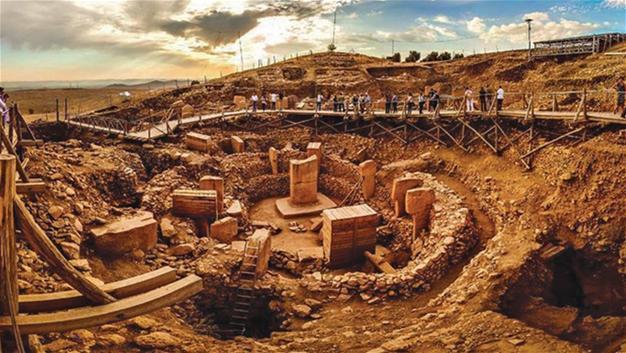Documentary depicts ancient Göbeklitepe as idol center from Abrahamic age
Ömer Erbil - ŞANLIURFA
 A documentary prepared jointly by TRT, the Diyarbakır Governor’s Office and the Turkish Development Ministry has claimed that the ancient statues in the world’s oldest-known temple were constructed by the Prophet Abraham’s father, Terah, prompting anger from archaeologists who say the claim is erroneous and misleading.
A documentary prepared jointly by TRT, the Diyarbakır Governor’s Office and the Turkish Development Ministry has claimed that the ancient statues in the world’s oldest-known temple were constructed by the Prophet Abraham’s father, Terah, prompting anger from archaeologists who say the claim is erroneous and misleading.The documentary, which was produced to introduce the cultural heritage of the southeastern province Diyarbakır, claims that a T-shape statue in Göbeklitepe with a fox motif was destroyed by Abraham.
During a part of the video in which the idol is destroyed, the narrator says: “Who can tell us that it was not Aser [Terah], father of Prophet Abraham, who built the statues in Göbeklitepe? Or can we claim that the temple where the idols that Prophet Abraham broke was not Göbeklitepe?”
Göbeklitepe has been dated to 12,000 years ago, well before the time in which Abraham is said to have lived.
Archeologist and publisher Nezih Başgelen said the purpose behind the move was to target Göbeklitepe.
“Within the framework of results that were obtained through scientific methods, Göbeklitepe dates back to 11,800-8,600 BCE. Here we see that there is a gap of around seven to eight thousand years between the date that scientific research has proved and the dates of religious references. Therefore, from this perspective, there are many problems in depicting Göbeklitepe as a communal site related to Prophet Abraham,” said Başgelen.
“Showing the statues as idols that were broken is dangerous targeting,” he said.
Located in Örencik, 18 kilometers from the center of the southeastern province of Şanlıurfa, Göbeklitepe was first discovered in 1963 during surface surveys carried out by researchers from the universities of Istanbul and Chicago.
Since 1995, the Şanlıurfa Museum and the German Archaeology Institute have been collaborating on the excavations.
Researchers have discovered 3- to 6-meter-long T-shaped steles weighing between 40 and 60 tons, the ruins of the world’s oldest temple, a large number of wild animal figures, human sculptures and a nearly 65-centimeter-long human sculpture from 12,000 years ago.
Many organizations, including the Culture and Tourism Ministry, have been conducting various projects for the promotion of Göbeklitepe, which is expected to enter the permanent list of UNESCO’s World Heritage Sites thanks to its historic texture, archaeological value and uniqueness.
















